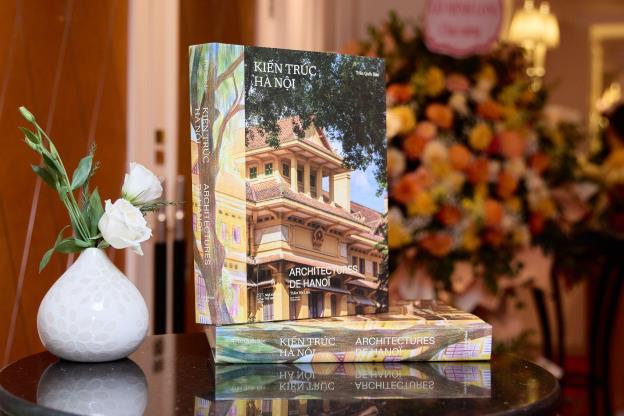 Life & Style
Life & Style


|
| Architect Nguyễn Quốc Khanh. |
Bilingual language Vietnamese-French book Kiến Trúc Hà Nội – Giao Thoa Văn Hóa Việt-Pháp (Hà Nội Architecture – Vietnamese French Culture Cross) was released by Thế Giới Publishing House and Phanbook Company.
The book has been compiled by a team including Vietnamese and French architects and experts.
Architect Nguyễn Quốc Khanh, the book's advisor, talked about how the title came about.
Could you tell us why did you engage in the book making?
In 2015, by chance, I read a book about Sài Gòn architecture in French. I was so impressed with the content of the book, I contacted the French cultural exchange IDECAF to request the copyright to reprint the book. After that, AA Company successfully republished the book Sài Gòn 1968 - 1998, Ba Thập Kỷ Phát Triển và Xây Dựng (Sài Gòn 1968 - 1998, Three Centuries of Development and Construction).
With the same love and ambition, we decided to compile the book Hà Nội Architecture - Vietnamese French Cultural Cross.
It is brought together by young Vietnamese people – the generation that will replace their fathers and ancestors continuing to preserve this priceless heritage, not only with responsibility, but also with pride and enjoyment. Without these feelings, they would hardly have been able to complete the book and remind each other to preserve the country's heritage for the future.
The team behind the project, the director to photographers, illustrators and others are all in their 30s and 40s. Together with the contributions and compilation of the seniors, who brought their extensive knowledge of heritage architecture, they have put all their heart and creativity into completing the book.
We are currently publishing the book in two languages, Vietnamese and French, with a view to it also coming out in English.
How long did it take to make the book?
We had many hurdles over the two years it took to compile the book.
Firstly, some buildings are not exactly the same as before, because people may have started to repair them, although most of them are still quite well preserved.
Secondly, many photos are not true to reality, because they have been covered with signs and advertising boards. Many buildings are difficult to access because they are now the headquarters of the Central Party Office or the Ministry of Foreign Affairs.
Then we had to hunt down original documents because we want the book to be academic, which means we need to know what the drawings were like in the past.
So the editors had to search for a lot of archival documents and the place where most of these documents are stored is in libraries in France.
Very fortunately, during the process, we were able to connect with Trần Hải Anh, the project manager, who spent much of his time sitting in the libraries in France taking pictures and sending them to us.
Another thing, which is really a challenge rather than a difficulty, is that there have been books about Hà Nội architecture in the past. Thus we had to make it new and better than those which were published before.

|
| The book's authors include Vietnamese and French architects and experts. — Photos thethaovanhoa.vn |
Is the architecture in the capital of the late 19th and early 20th century the main theme of the book?
Hà Nội after 1954 has some impressive works. However, the book is focusing on the architectural heritage of the late 19th and early 20th centuries.
Hà Nội architects also suggested that the part about the capital's architecture after 1954 could be in another book.
I really hope that a large number of readers, including the young, understand Hà Nội's cultural heritage through architectural art and at the same time, promote the value of that heritage in today's life.
Compared to other Southeast Asian cities, Hà Nội has such a valuable heritage. Despite two wars, Hà Nội still has retained most of its architectural heritage, built from the feudal period to the French colonial period.
These are beautiful works designed by French and Vietnamese architects, artisans and workers.
These heritages need to be preserved, inspiring future generations of creators.
The book is sold at VNĐ2.5 million (roughly US$100). Is the price suitable for the young readers?
The content of the book is purely academic, so it is not aimed at being a popular type book. However, the book layout is eye-catching, so I believe that it will be received warmly by young readers.
The book price is higher in Việt Nam, but it is similar to other countries like China with the same standard.
The books are bilingual and intended for foreign readers. I have to buy foreign architecture books at a high price, so really the book price is reasonable. In fact, there are young people spending a few million of đồng to buy a pair of shoes or a set of clothes. Personally, I think the book should not be displayed on the usual bookshelf, but can be placed on the table as a souvenir and family members can open it to read at any time.
Do you think that Hà Nội architecture heritage plays a role in attracting tourists?
I think that, for a place to become attractive, there needs to be a harmonious combination of factors. I still enjoy Hà Nội's Old Quarter. Hà Nội's 36 streets always have their own beauty, even in late autumn or early winter.
However, the main challenge is to preserve the ancient beauty of the Old Quarter. It is a unique beauty that young cities like Bangkok or Singapore cannot have.
Hopefully, the young people will love Hà Nội's culture and architectural heritage, thereby being aware of preserving and promoting its value in the future. — VNS